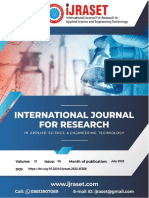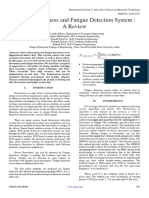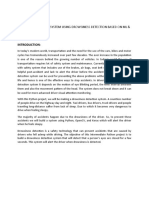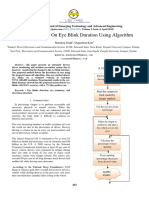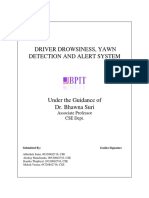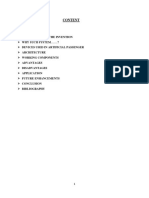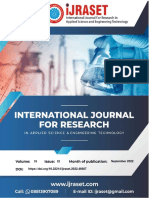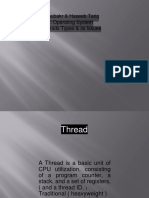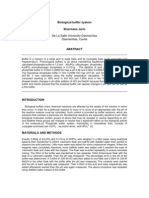Professional Documents
Culture Documents
Driver Drowsiness Detection Using Machine Learning and Open CV
Copyright
Available Formats
Share this document
Did you find this document useful?
Is this content inappropriate?
Report this DocumentCopyright:
Available Formats
Driver Drowsiness Detection Using Machine Learning and Open CV
Copyright:
Available Formats
Volume 7, Issue 7, July – 2022 International Journal of Innovative Science and Research Technology
ISSN No:-2456-2165
Driver Drowsiness Detection using Machine
Learning and open CV
Lavanya N Nithin Db 4AD18CS050
Guide, Assistant professor, CSE Syed Hameed Ur Rahman 4AD18CS081
Dept. of Computer Science and Engineering Syed Suhail 4AD18CS082
ATMECE, Mysore. BE CSE, Dept. of CSE ATMECE, Mysore.
Abstract:- Intoxicated driving, sleepiness, and reckless The head forward, among others. Various measures are
driving are the most common causes of accidents and deaths used to assess the degree of driver drowsiness. In their Global
globally, and the major causes of these accidents are usually Status Report on Road Safety, the World Health Organization
drunken driving, drowsiness, and reckless driving. named tiredness, drinking, and carelessness as major causes of
According to the United Nations, road traffic injuries have traffic accidents.
increased to 1.25 billion worldwide, making driver
sleepiness detection a significant issue. A promising area for As a result, the deaths and resulting costs pose a serious
preventing countless sleep-related traffic accidents. This threat to families all over the world. Because of their high cost
research provides a machine-based method for detecting and limited availability, current sleepiness detection systems
tiredness. As a result of the learning algorithms, the driver are not widely employed, rendering them unsuitable for usage
is alerted in real-time. To avoid a collision The Haar in everyday or non-luxury vehicles. As a result, a clever and
Cascade method is used in the model. Along with the viable solution is becoming increasingly necessary. Numerous
OpenCV library to keep track of real-time video the driving autos have a sleepiness detection system. Can swiftly adjust in
and to detect the driver's eyes the system makes use of the the industry Machine-related fields Artificial intelligence and
Eye Aspect Ratio (EAR) notion is used to detect whether or machine learning have aided in the development of several
not the eyes are open. products. Breakthroughs that employ various algorithms Clever
and self-contained model.
Keywords:- Drowsiness, Threshold, Eye Aspect Ratio,
Drowsiness. The Haar Cascade technique, which is paired with several
Python modules to capture and identify drowsiness in real time,
I. INTRODUCTION is proposed in this model. Because the method is optimal in
speed and accuracy, this model is effective at detecting
Driver sleepiness detection is critical in car safety drowsiness.
technologies to avoid road accidents. Many people nowadays
rely on automobiles for everyday commuting, greater living II. METHODOLOGY
standards, comfort, and time restrictions to get to their
objectives. This trend results in heavy traffic in cities and on The suggested system employs Haar Cascades to
roads. As a result of various reasons, the number of traffic recognize items in real time, such as the driver's face and eyes.
accidents will increase. The model makes use of libraries like OpenCV, Dlib, and GPIO
to make the software and the hardware input/output easier.
Drowsy driving may be the primary cause of car accidents.
Early detection of driver drowsiness and notifying with an EYE AR THRESH for the eye aspect ratio to indicate a
alarm is one technique to reduce the incidence of accidents. blink and EYE EAR CONSEC FRAMES for the amount of
Accidents are frequently caused by drivers who are sleep consecutive frames the system will monitor to detect
deprived. To prevent road accidents, technology for detecting drowsiness are the first two constants defined by the software.
driver drowsiness is essential. For both the industrial and
research communities, developing this technology is a major We then set the frame counter 'COUNTER' to 0 and the
undertaking. Boolean 'ALARM ON' to OFF, which keeps track of the
number of frames for open and closed eyes as well as the alarm
While driving, various indicators of driver drowsiness can status. Now we'll set up the Dlib's HOG-based face detector and
be detected, such as the inability to keep one's eyes open, use it to build the facial landmark predictor.
frequent yawning, and moving.
IJISRT22JUL431 www.ijisrt.com 111
Volume 7, Issue 7, July – 2022 International Journal of Innovative Science and Research Technology
ISSN No:-2456-2165
For yawn detection, a YAWN value will be calculated and III. ALGORITHM
compared to a threshold value utilizing the distance between the
upper and lower lips. This diagram shows how the sleepiness detection system
works in its entirety.
The eSpeak (text to speech synthesizer) module is used to It explains why each stage in the sleepiness detection
offer pertinent voice alerts when the driver is weary or yawning. process is so important.
Notice how the camera's brightness and contrast levels are
modified initially.
The face is then discovered.
Only the next step is taken if it is successfully previewed.
The detection of the eyes occurs.
The eye region is targeted and removed when a decision is
made for proper eye detection.
Whether the eyes are closed or opened is determined.
Drowsiness is determined by the info that is saved and
stored.
Now is the time to assess sleepiness.
If he is drowsy, the alarm goes off loudly and he gets alerted.
Fig 1: Eye Aspect Ratio
As seen in Figure, the eye aspect ratio controls whether or
not the eyes are open. As the eye is open, the EAR is rather
constant, but when the eye blinks, it swiftly drops to zero; hence
it is used to detect a blink in a single frame. We can also
eliminate image processing procedures by using this simple
equation to obtain the ratio of eye landmark distances. When a
person blinks.
Fig 2: Formula for EAR
EAR is used to determine ocular openness. Now we
compute the convex hull for the left and right eyes by averaging
the eye aspect ratios for both eyes ((left EAR + right EAR) /
2.0). If the eyes are open, we color them green; if they are
closed, we color them red. If the eye aspect ratio is less than the
blink threshold, the condition statement increments the blink
frame counter.
We sound the alarm if the eyes identified are closed for
five frames in a row. Otherwise, the counter is reset to 0. We
loop back to the next frame and repeat the technique for the
current frame until one iteration for a frame is accomplished. Fig 3
IJISRT22JUL431 www.ijisrt.com 112
Volume 7, Issue 7, July – 2022 International Journal of Innovative Science and Research Technology
ISSN No:-2456-2165
IV. ADVANTAGES
Because the system consumes fewer resources, it is less
expensive.
Improved driving efficiency and safety.
Less manual labor.
The method also saves time and effort for humans
No driver weariness.
V. CONCLUSION
The proposed method assists the driver in remaining alert
while driving and reduces sleep-related accidents.
The buzzer is in charge of notifying the driver by sending
sound signals, which effectively awakens the driver in real time
to prevent road accidents.
The Haar cascade classifier lowers erroneous eye
detections by calculating the Eye aspect ratio, which is a
problem with models that just use the OpenCV library.
The Eye aspect ratio of consecutive frames will aid us in
removing minor inaccuracies and accurately calculating
drowsiness.
REFERENCES
[1]. Kyong Hee Lee, Whui Kim, Hyun Kyun Choi, Byung Tae
Jan. “A Study on Feature Extraction Methods Used to
Estimate a Driver’s Level of Drowsiness”, IEEE,
February 2019.
[2]. Fouzia, Roopalakshmi R, Jayantkumar A Rathod,
Ashwitha S, Supriya K, “Driver Drowsiness Detection
System Based on Visual Features.” , IEEE, April 2018.
[3]. Shivani Sheth, Aditya Singhal, V.V Ramalingam. “Driver
Drowsiness Detection system using Machine Learning
Algorithms”, IEEE, March 2020.
IJISRT22JUL431 www.ijisrt.com 113
You might also like
- Driver Fatigue Detection System (DFDS)Document14 pagesDriver Fatigue Detection System (DFDS)tanisha gargNo ratings yet
- Driver Drowsiness Detection Using OpenCV and Raspberry PiDocument7 pagesDriver Drowsiness Detection Using OpenCV and Raspberry PiIJRASETPublicationsNo ratings yet
- Driver Drowsiness Detection SystemDocument5 pagesDriver Drowsiness Detection SystemInternational Journal of Innovative Science and Research TechnologyNo ratings yet
- Driver Alert System Based On Eye RecognitionDocument20 pagesDriver Alert System Based On Eye Recognitionhostel boysNo ratings yet
- Real-Time Driver Drowsiness Detection Using Computer Vision: Mahek Jain, Bhavya Bhagerathi, Sowmyarani C NDocument5 pagesReal-Time Driver Drowsiness Detection Using Computer Vision: Mahek Jain, Bhavya Bhagerathi, Sowmyarani C NJoynul Abedin ZubairNo ratings yet
- Driver Drowsiness Detection Using Machine LearningDocument6 pagesDriver Drowsiness Detection Using Machine LearningIJRASETPublicationsNo ratings yet
- JECA - 3373Document4 pagesJECA - 3373ashutoshbhoite007No ratings yet
- Driver Drowsiness Detection Using Haar CascadeDocument9 pagesDriver Drowsiness Detection Using Haar CascadeIJRASETPublicationsNo ratings yet
- Arduino Based Driver Drowsiness Detection & Alerting System - PagenumberDocument8 pagesArduino Based Driver Drowsiness Detection & Alerting System - Pagenumberkanisivam2005No ratings yet
- IR Sensor Based Drowsiness Detecting During Driving SystemDocument3 pagesIR Sensor Based Drowsiness Detecting During Driving SystemsasaddaNo ratings yet
- Driver Drowsiness Detection and Alert System Based On Visual Analysis Using Machine LearningDocument6 pagesDriver Drowsiness Detection and Alert System Based On Visual Analysis Using Machine LearningIJRASETPublicationsNo ratings yet
- Accident Avoidance System Using Drowsiness Detection Based On ML & IpDocument16 pagesAccident Avoidance System Using Drowsiness Detection Based On ML & IpVishal LabdeNo ratings yet
- Driver Drowsiness Detection Using Opencv PythonDocument17 pagesDriver Drowsiness Detection Using Opencv PythonFahma FamzinNo ratings yet
- Project Proposal: Drowsiness Detection While Driving Using Eye-TrackingDocument8 pagesProject Proposal: Drowsiness Detection While Driving Using Eye-TrackingAlee HussainNo ratings yet
- Reference Paper 5Document4 pagesReference Paper 5Krishna BasutkarNo ratings yet
- Survey Paper For Real Time Car Driver Drowsiness Detection Using Machine Learning ApproachDocument8 pagesSurvey Paper For Real Time Car Driver Drowsiness Detection Using Machine Learning ApproachIJRASETPublicationsNo ratings yet
- DrowsinessDocument16 pagesDrowsinessALNATRON GROUPSNo ratings yet
- Review Paper On Driver Drowsiness Detection System Using Machine LearningDocument4 pagesReview Paper On Driver Drowsiness Detection System Using Machine LearningSwekcha SrivastavaNo ratings yet
- Driver Drowsiness and Fatigue Detection System A ReviewDocument4 pagesDriver Drowsiness and Fatigue Detection System A ReviewInternational Journal of Innovative Science and Research TechnologyNo ratings yet
- Drowsiness Detection System Using Haar Classifiers: Shubham Kumar Singh, Smit Soni, Sonu Suman, Prof. Soumyalatha NaveenDocument6 pagesDrowsiness Detection System Using Haar Classifiers: Shubham Kumar Singh, Smit Soni, Sonu Suman, Prof. Soumyalatha NaveenRitwik RathourNo ratings yet
- A Survey Fatigue Monitoring SystemDocument3 pagesA Survey Fatigue Monitoring Systemlambert macheteNo ratings yet
- A Survey On Driver Drowsiness Detection TechniquesDocument5 pagesA Survey On Driver Drowsiness Detection Techniquesassasaa asasaNo ratings yet
- IEEE Research Paper For Drowsiness Detection System ProjectDocument8 pagesIEEE Research Paper For Drowsiness Detection System Projecttanisha gargNo ratings yet
- Driver Drowsiness Detection System Published Review PaperDocument3 pagesDriver Drowsiness Detection System Published Review PaperShivangi SrivastavaNo ratings yet
- Survey On Drowsiness Detection and Alert System Using ML ApproachDocument10 pagesSurvey On Drowsiness Detection and Alert System Using ML ApproachIJRASETPublicationsNo ratings yet
- Presentation On Sleep Alarm System by Aayushi DadoreDocument17 pagesPresentation On Sleep Alarm System by Aayushi Dadoreaayushi dadoreNo ratings yet
- Paper2 - HWDocument4 pagesPaper2 - HWVishal LabdeNo ratings yet
- A Review Paper On Detection of Drivers FDocument4 pagesA Review Paper On Detection of Drivers FAditya patilNo ratings yet
- Accident Avoidance System Using Drowsiness Detection Based On ML & IPDocument6 pagesAccident Avoidance System Using Drowsiness Detection Based On ML & IPVishal LabdeNo ratings yet
- Driver Drowsiness Detection Using Machine Learning With Visual BehaviourDocument6 pagesDriver Drowsiness Detection Using Machine Learning With Visual Behaviourchaitrashivaram17No ratings yet
- Drowsy Detection On Eye Blink Duration Using AlgorithmDocument3 pagesDrowsy Detection On Eye Blink Duration Using Algorithmmuhammad Ehsan UllahNo ratings yet
- Real Time Fatigue Detection System Using Computer Vision IJERTV9IS060921Document5 pagesReal Time Fatigue Detection System Using Computer Vision IJERTV9IS060921Sandeep KumarNo ratings yet
- Drowsiness Detection System IJERTCONV3IS06014Document2 pagesDrowsiness Detection System IJERTCONV3IS06014Ralu KumarNo ratings yet
- Drowsiness Detection System Using MLDocument7 pagesDrowsiness Detection System Using MLIJARSCT JournalNo ratings yet
- INTRODUCTIONDDDDocument2 pagesINTRODUCTIONDDD217y1a66g4No ratings yet
- Driver Drowsy 2nd PhaseDocument22 pagesDriver Drowsy 2nd PhaseShreya MNo ratings yet
- Machine Learning Based Driver Drowsiness DetectionDocument16 pagesMachine Learning Based Driver Drowsiness DetectionSwekcha Srivastava0% (1)
- YMER210479Document8 pagesYMER210479Ralu KumarNo ratings yet
- Real-Time Driver Drowsiness Identification Based On Eye-State AnalysisDocument6 pagesReal-Time Driver Drowsiness Identification Based On Eye-State AnalysisIJRASETPublicationsNo ratings yet
- Drowsiness Detection System Using Machine LearningDocument4 pagesDrowsiness Detection System Using Machine LearningNIET Journal of Engineering & Technology(NIETJET)No ratings yet
- Drowsiness Driving Detection, Prediction and Warning Drowsiness DetectionDocument6 pagesDrowsiness Driving Detection, Prediction and Warning Drowsiness DetectionInternational Journal of Innovative Science and Research TechnologyNo ratings yet
- Driver Drowsiness Detection System Using Raspberry PiDocument7 pagesDriver Drowsiness Detection System Using Raspberry PiIJRASETPublicationsNo ratings yet
- IoT-Powered Technologies and Machine Learning Based Driver Drowsiness Detection SystemDocument11 pagesIoT-Powered Technologies and Machine Learning Based Driver Drowsiness Detection SystemInternational Journal of Innovative Science and Research TechnologyNo ratings yet
- Research Paper (OjhugDocument5 pagesResearch Paper (OjhugKaushal PathakNo ratings yet
- Shock 2 Lazy Drivers Using Image Processing: P.Ramanaiah K.Arun SekharDocument10 pagesShock 2 Lazy Drivers Using Image Processing: P.Ramanaiah K.Arun Sekharbalu54No ratings yet
- Alshaqaqi 2013Document5 pagesAlshaqaqi 2013ehsanNo ratings yet
- Driver Drowsiness SynopsisDocument11 pagesDriver Drowsiness Synopsisakshat shakarwalNo ratings yet
- Eye Tracking Based Driver Fatigue Monitoring and WarningDocument30 pagesEye Tracking Based Driver Fatigue Monitoring and WarningHARDEEP SINGH100% (2)
- Artificial PassengerDocument20 pagesArtificial Passengerdaman.arneja143No ratings yet
- Drowsy Driver Warning For Accident-Avoidance System Using Image ProcessingDocument6 pagesDrowsy Driver Warning For Accident-Avoidance System Using Image ProcessingIJRASETPublicationsNo ratings yet
- Detection of Eye Blinking and Yawning For Monitoring Driver's Drowsiness in Real TimeDocument8 pagesDetection of Eye Blinking and Yawning For Monitoring Driver's Drowsiness in Real TimeInternational Journal of Application or Innovation in Engineering & ManagementNo ratings yet
- Driver Drowsiness Detection System: Athira Gopal, V.V VineethDocument4 pagesDriver Drowsiness Detection System: Athira Gopal, V.V VineethAhmed DanishNo ratings yet
- Paper 8Document4 pagesPaper 8Aditya SinghNo ratings yet
- Phase 1 PPT DoneDocument20 pagesPhase 1 PPT DoneDeepthiNo ratings yet
- Real-Time Driver Drowsiness Detection System Using Facial FeaturesDocument7 pagesReal-Time Driver Drowsiness Detection System Using Facial FeaturesIJRASETPublicationsNo ratings yet
- Real-Time Driver Drowsiness Detection Using Deep LearningDocument7 pagesReal-Time Driver Drowsiness Detection Using Deep LearningVishal LabdeNo ratings yet
- Eye Behaviour Based Drowsiness Detection SystemDocument5 pagesEye Behaviour Based Drowsiness Detection Systemsaurabh ghugeNo ratings yet
- A Survey Paper On Drowsiness Detection & Alarm System For DriversDocument5 pagesA Survey Paper On Drowsiness Detection & Alarm System For DriversAmaanNo ratings yet
- A Review On Drowsy Driver Detection in Digital Image ProcessingDocument10 pagesA Review On Drowsy Driver Detection in Digital Image ProcessingIJRASETPublicationsNo ratings yet
- Compact and Wearable Ventilator System for Enhanced Patient CareDocument4 pagesCompact and Wearable Ventilator System for Enhanced Patient CareInternational Journal of Innovative Science and Research TechnologyNo ratings yet
- Insights into Nipah Virus: A Review of Epidemiology, Pathogenesis, and Therapeutic AdvancesDocument8 pagesInsights into Nipah Virus: A Review of Epidemiology, Pathogenesis, and Therapeutic AdvancesInternational Journal of Innovative Science and Research TechnologyNo ratings yet
- Implications of Adnexal Invasions in Primary Extramammary Paget’s Disease: A Systematic ReviewDocument6 pagesImplications of Adnexal Invasions in Primary Extramammary Paget’s Disease: A Systematic ReviewInternational Journal of Innovative Science and Research TechnologyNo ratings yet
- Smart Cities: Boosting Economic Growth through Innovation and EfficiencyDocument19 pagesSmart Cities: Boosting Economic Growth through Innovation and EfficiencyInternational Journal of Innovative Science and Research TechnologyNo ratings yet
- Air Quality Index Prediction using Bi-LSTMDocument8 pagesAir Quality Index Prediction using Bi-LSTMInternational Journal of Innovative Science and Research TechnologyNo ratings yet
- An Analysis on Mental Health Issues among IndividualsDocument6 pagesAn Analysis on Mental Health Issues among IndividualsInternational Journal of Innovative Science and Research TechnologyNo ratings yet
- The Making of Object Recognition Eyeglasses for the Visually Impaired using Image AIDocument6 pagesThe Making of Object Recognition Eyeglasses for the Visually Impaired using Image AIInternational Journal of Innovative Science and Research TechnologyNo ratings yet
- Harnessing Open Innovation for Translating Global Languages into Indian LanuagesDocument7 pagesHarnessing Open Innovation for Translating Global Languages into Indian LanuagesInternational Journal of Innovative Science and Research TechnologyNo ratings yet
- Parkinson’s Detection Using Voice Features and Spiral DrawingsDocument5 pagesParkinson’s Detection Using Voice Features and Spiral DrawingsInternational Journal of Innovative Science and Research TechnologyNo ratings yet
- Dense Wavelength Division Multiplexing (DWDM) in IT Networks: A Leap Beyond Synchronous Digital Hierarchy (SDH)Document2 pagesDense Wavelength Division Multiplexing (DWDM) in IT Networks: A Leap Beyond Synchronous Digital Hierarchy (SDH)International Journal of Innovative Science and Research TechnologyNo ratings yet
- Investigating Factors Influencing Employee Absenteeism: A Case Study of Secondary Schools in MuscatDocument16 pagesInvestigating Factors Influencing Employee Absenteeism: A Case Study of Secondary Schools in MuscatInternational Journal of Innovative Science and Research TechnologyNo ratings yet
- Exploring the Molecular Docking Interactions between the Polyherbal Formulation Ibadhychooranam and Human Aldose Reductase Enzyme as a Novel Approach for Investigating its Potential Efficacy in Management of CataractDocument7 pagesExploring the Molecular Docking Interactions between the Polyherbal Formulation Ibadhychooranam and Human Aldose Reductase Enzyme as a Novel Approach for Investigating its Potential Efficacy in Management of CataractInternational Journal of Innovative Science and Research TechnologyNo ratings yet
- Comparatively Design and Analyze Elevated Rectangular Water Reservoir with and without Bracing for Different Stagging HeightDocument4 pagesComparatively Design and Analyze Elevated Rectangular Water Reservoir with and without Bracing for Different Stagging HeightInternational Journal of Innovative Science and Research TechnologyNo ratings yet
- The Relationship between Teacher Reflective Practice and Students Engagement in the Public Elementary SchoolDocument31 pagesThe Relationship between Teacher Reflective Practice and Students Engagement in the Public Elementary SchoolInternational Journal of Innovative Science and Research TechnologyNo ratings yet
- Diabetic Retinopathy Stage Detection Using CNN and Inception V3Document9 pagesDiabetic Retinopathy Stage Detection Using CNN and Inception V3International Journal of Innovative Science and Research TechnologyNo ratings yet
- The Utilization of Date Palm (Phoenix dactylifera) Leaf Fiber as a Main Component in Making an Improvised Water FilterDocument11 pagesThe Utilization of Date Palm (Phoenix dactylifera) Leaf Fiber as a Main Component in Making an Improvised Water FilterInternational Journal of Innovative Science and Research TechnologyNo ratings yet
- Advancing Healthcare Predictions: Harnessing Machine Learning for Accurate Health Index PrognosisDocument8 pagesAdvancing Healthcare Predictions: Harnessing Machine Learning for Accurate Health Index PrognosisInternational Journal of Innovative Science and Research TechnologyNo ratings yet
- Auto Encoder Driven Hybrid Pipelines for Image Deblurring using NAFNETDocument6 pagesAuto Encoder Driven Hybrid Pipelines for Image Deblurring using NAFNETInternational Journal of Innovative Science and Research TechnologyNo ratings yet
- Formulation and Evaluation of Poly Herbal Body ScrubDocument6 pagesFormulation and Evaluation of Poly Herbal Body ScrubInternational Journal of Innovative Science and Research TechnologyNo ratings yet
- Electro-Optics Properties of Intact Cocoa Beans based on Near Infrared TechnologyDocument7 pagesElectro-Optics Properties of Intact Cocoa Beans based on Near Infrared TechnologyInternational Journal of Innovative Science and Research TechnologyNo ratings yet
- Terracing as an Old-Style Scheme of Soil Water Preservation in Djingliya-Mandara Mountains- CameroonDocument14 pagesTerracing as an Old-Style Scheme of Soil Water Preservation in Djingliya-Mandara Mountains- CameroonInternational Journal of Innovative Science and Research TechnologyNo ratings yet
- Explorning the Role of Machine Learning in Enhancing Cloud SecurityDocument5 pagesExplorning the Role of Machine Learning in Enhancing Cloud SecurityInternational Journal of Innovative Science and Research TechnologyNo ratings yet
- The Impact of Digital Marketing Dimensions on Customer SatisfactionDocument6 pagesThe Impact of Digital Marketing Dimensions on Customer SatisfactionInternational Journal of Innovative Science and Research TechnologyNo ratings yet
- Navigating Digitalization: AHP Insights for SMEs' Strategic TransformationDocument11 pagesNavigating Digitalization: AHP Insights for SMEs' Strategic TransformationInternational Journal of Innovative Science and Research Technology100% (1)
- A Survey of the Plastic Waste used in Paving BlocksDocument4 pagesA Survey of the Plastic Waste used in Paving BlocksInternational Journal of Innovative Science and Research TechnologyNo ratings yet
- Design, Development and Evaluation of Methi-Shikakai Herbal ShampooDocument8 pagesDesign, Development and Evaluation of Methi-Shikakai Herbal ShampooInternational Journal of Innovative Science and Research Technology100% (3)
- A Review: Pink Eye Outbreak in IndiaDocument3 pagesA Review: Pink Eye Outbreak in IndiaInternational Journal of Innovative Science and Research TechnologyNo ratings yet
- Cyberbullying: Legal and Ethical Implications, Challenges and Opportunities for Policy DevelopmentDocument7 pagesCyberbullying: Legal and Ethical Implications, Challenges and Opportunities for Policy DevelopmentInternational Journal of Innovative Science and Research TechnologyNo ratings yet
- Hepatic Portovenous Gas in a Young MaleDocument2 pagesHepatic Portovenous Gas in a Young MaleInternational Journal of Innovative Science and Research TechnologyNo ratings yet
- Automatic Power Factor ControllerDocument4 pagesAutomatic Power Factor ControllerInternational Journal of Innovative Science and Research TechnologyNo ratings yet
- Thread Types & IssuesDocument20 pagesThread Types & IssuesBilal Khan RindNo ratings yet
- OSY Practical No.1Document18 pagesOSY Practical No.1aniket bhoirNo ratings yet
- Lab 1 Introduction To Power System Protection UpdatedDocument21 pagesLab 1 Introduction To Power System Protection UpdatedKhadijaNo ratings yet
- Acog Practice Bulletin: Antepartum Fetal SurveillanceDocument12 pagesAcog Practice Bulletin: Antepartum Fetal SurveillanceMariana Hernandez100% (10)
- Mech 2 Module 1 Unit 3 (Position, Velocity and Acceleration)Document8 pagesMech 2 Module 1 Unit 3 (Position, Velocity and Acceleration)Zamantha DomingoNo ratings yet
- Chapter 5 - Protein Purification and Characterization Techniques (1) (Compatibility Mode)Document23 pagesChapter 5 - Protein Purification and Characterization Techniques (1) (Compatibility Mode)Nadine SabadoNo ratings yet
- Practice 24 - PDB Cloning and Relocation Using DBCADocument11 pagesPractice 24 - PDB Cloning and Relocation Using DBCALogis M100% (1)
- Band Pass Filter Lab, A Discussion of The Mechanism of Op-AmpsDocument6 pagesBand Pass Filter Lab, A Discussion of The Mechanism of Op-AmpsJoe O'Hara100% (2)
- Making A Prallel Jaw Bar ClampDocument34 pagesMaking A Prallel Jaw Bar ClampHomayoon GeramifarNo ratings yet
- PMP Lesson 8: Name: Class: DateDocument12 pagesPMP Lesson 8: Name: Class: DateYas AlbNo ratings yet
- TEK 12-6 Reinforcement & Connectors (2007)Document6 pagesTEK 12-6 Reinforcement & Connectors (2007)B0B_PNo ratings yet
- Science 10 - Set 2 - DS 1Document10 pagesScience 10 - Set 2 - DS 1DhejehNo ratings yet
- Topographical SurveysDocument27 pagesTopographical SurveysRomeo ZsurzsNo ratings yet
- LevofloxacinDocument2 pagesLevofloxacinNasir KhanNo ratings yet
- Critical Buckling EquationDocument18 pagesCritical Buckling Equationxsi666No ratings yet
- Control System Lab Using MATLAB: (ELE 302L)Document23 pagesControl System Lab Using MATLAB: (ELE 302L)Abhilasha PaliwalNo ratings yet
- Sop SopDocument12 pagesSop Soperic_agustianNo ratings yet
- TM11-2637 Test Set Espey Model 100, 1945Document64 pagesTM11-2637 Test Set Espey Model 100, 1945david_graves_okstateNo ratings yet
- 3 Journal of Solid State Electrochemistry PDFDocument11 pages3 Journal of Solid State Electrochemistry PDFEDITORS CRC BOOKNo ratings yet
- Pricing Determination Procedure PDFDocument62 pagesPricing Determination Procedure PDFTaslimNo ratings yet
- AOCS Annual Meeting 2020 Surfactants Detergents AbstractsDocument47 pagesAOCS Annual Meeting 2020 Surfactants Detergents AbstractsJonathan DiamondNo ratings yet
- Biological Buffer SystemDocument4 pagesBiological Buffer SystemSharm Jarin-AlonzoNo ratings yet
- Assignment-5 Enmt610029 Welding ANDARADHI NARARYA/1206291992Document8 pagesAssignment-5 Enmt610029 Welding ANDARADHI NARARYA/1206291992Andaradhi NararyaNo ratings yet
- Arbitrary Video Style Transfer Via Multi-Channel CorrelationDocument8 pagesArbitrary Video Style Transfer Via Multi-Channel CorrelationHristoNo ratings yet
- Lectura 2 A Review On Stability Testing Guidelines 2020Document7 pagesLectura 2 A Review On Stability Testing Guidelines 2020Justina MoncadaNo ratings yet
- Higher Nationals - Internal Verification of Assessment Decisions - BTEC (RQF)Document55 pagesHigher Nationals - Internal Verification of Assessment Decisions - BTEC (RQF)Cool MarttNo ratings yet
- Pelatihan Kader: Lampiran Uji StatistikDocument2 pagesPelatihan Kader: Lampiran Uji StatistikSiti Hidayatul FitriNo ratings yet
- Hostel Management SRS PDFDocument17 pagesHostel Management SRS PDFVanitha Vani64% (14)
- AMD64 16h InstrLatency 1.1Document79 pagesAMD64 16h InstrLatency 1.1mario nogueraNo ratings yet


